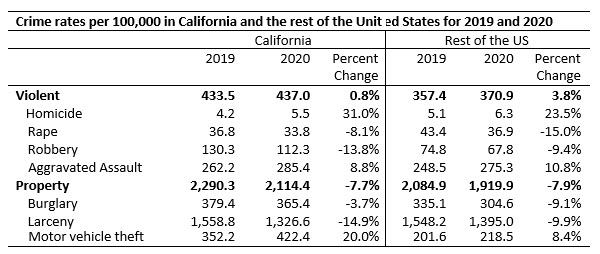

By David M. Greenwald
Executive Editor
Berkeley, CA – More research continues to show that the crime trends during the pandemic are uneven and complicated.
This week, research released by the nonpartisan California Policy Lab (CPL) shows that “as the COVID-19 pandemic disrupted daily lives, crime in California and across the country also changed in dramatic ways.” The report analyzed violent and property crime in 2020 as compared to 2019, and compared California to the rest of the U.S.
Overall, like other findings, the violent crime in California increased slightly between 2019 and 2020. The violent crime rate in the rest of the country increased by a larger margin.
“However, when you look at specific crime types within the violent crime category, there were some diverging trends,” explains Steve Raphael, a public policy professor at UC Berkeley and co-author of the analysis. “In California, homicides increased by 31% and aggravated assaults increased by 9%, while robberies decreased by 14% and rapes decreased by 8%.”
He said, “The increases in certain crime rates, especially homicide, are troubling, though it’s also important to keep in mind that California’s homicide rate is 61.8% less than its peak in 1980.”
But, at the same time, property crime in California decreased by 7.7% in 2020, driven by decreases in burglary and larceny that offset an increase in motor vehicle thefts.

Some of the key findings include the fact that “recent crime rates in California remain much lower than historical averages during the 1980s and 90s,” despite the changes during the pandemic.
“Between 2019 and 2020, property crime declined by 8% in California, while violent crime increased slightly by 0.8%,” the study found. “Overall, other states have experienced larger increases in violent crime and similar decreases in property crime.”
But even that is misleading.
The report found, “California’s overall violent crime rate masks diverging trends among specific crime types: homicides increased by 31% and aggravated assaults increased by 9%, while robberies decreased by 14% and rapes decreased by 8%. These trends match those in other states.”
Further, “California experienced a 15% decrease in larceny (personal property theft) and a 20% increase in motor vehicle theft. Both trends are larger in magnitude than those in other states.”
They also found, “Within California, the largest changes in crime rates occurred in cities with high baseline rates in 2019.”
One of the key findings in these studies is that crime rates are going up across the country, and thus attributing them to local factors such as prosecution practices or reform efforts is tricky.
Furthermore, the pandemic itself may be causing some of these trends. The report, like many others, continues to highlight the fact that “crime rates in California remain at historic lows.” And, in fact, “Crime rates in California and throughout the United States have dropped dramatically over the past three decades.”
The release by the Berkeley group mirrors other releases this week showing similar trends.
Fordham Law Professor John Pfaff pushed back on the fact that many reformers have attempted to downplay the spike in homicides.
“I feel like trying to underplay a historic spike in homicides (and a likely spike in shootings) by pointing out that all OTHER crimes mostly fell is a not a great strategy for reformers,” he tweeted on Monday. He argued, “It actually plays into Tough-on-crime’s hands.
“Crime went down,” he said but “Where the asterisk is… except for the biggest, most politically salient one that terrifies people the most.”
Instead, he argued, “The fact is we should push for reforms BECAUSE homicides spiked. BECAUSE usual approaches have big social costs we don’t measure. BECAUSE there is a better way to address crime WHEN IT RISES.”
He continued, “Invoking the ‘… except for murder’ argument plays RIGHT into the status quo’s hands.”
